air condition SKODA FABIA 2009 2.G / 5J Owner's Manual
[x] Cancel search | Manufacturer: SKODA, Model Year: 2009, Model line: FABIA, Model: SKODA FABIA 2009 2.G / 5JPages: 259, PDF Size: 31.99 MB
Page 4 of 259
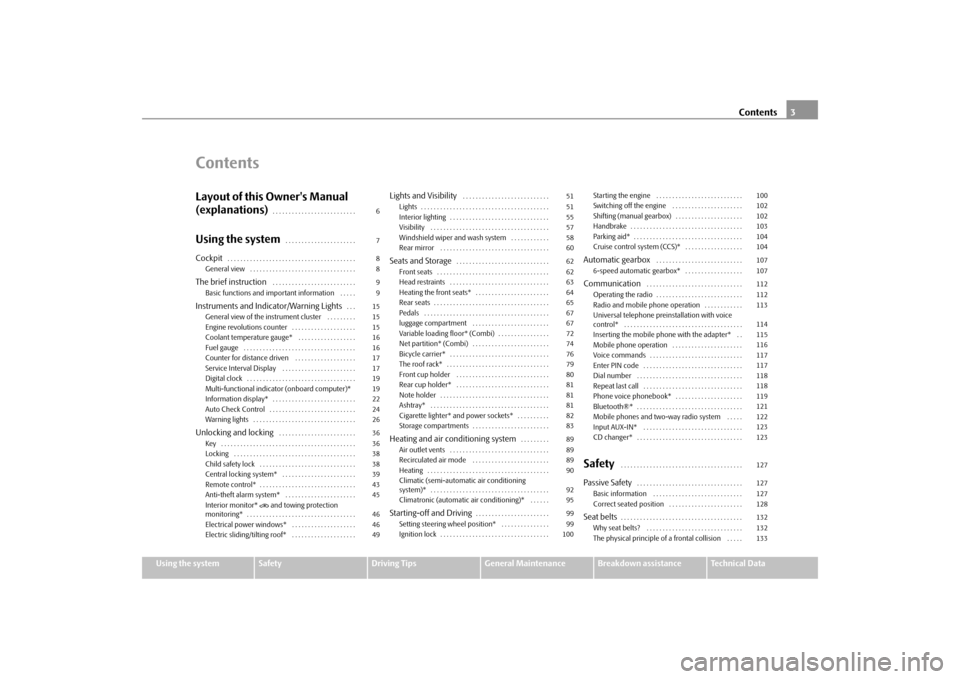
Contents3
Using the system
Safety
Driving Tips
General Maintenance
Breakdown assistance
Technical Data
ContentsLayout of this Owner's Manual
(explanations)
. . . . . . . . . . . . . . . . . . . . . . . . . .
Using the system
. . . . . . . . . . . . . . . . . . . . . .
Cockpit
. . . . . . . . . . . . . . . . . . . . . . . . . . . . . . . . . . . . . . . .
General view . . . . . . . . . . . . . . . . . . . . . . . . . . . . . . . . .
The brief instruction
. . . . . . . . . . . . . . . . . . . . . . . . . .
Basic functions and important information . . . . .
Instruments and Indicator/Warning Lights
. . .
General view of the instrument cluster . . . . . . . . .
Engine revolutions counter . . . . . . . . . . . . . . . . . . . .
Coolant temperature gauge* . . . . . . . . . . . . . . . . . .
Fuel gauge . . . . . . . . . . . . . . . . . . . . . . . . . . . . . . . . . . .
Counter for distance driven . . . . . . . . . . . . . . . . . . .
Service Interval Display . . . . . . . . . . . . . . . . . . . . . . .
Digital clock . . . . . . . . . . . . . . . . . . . . . . . . . . . . . . . . . .
Multi-functional indicator (onboard computer)*
Information display* . . . . . . . . . . . . . . . . . . . . . . . . . .
Auto Check Control . . . . . . . . . . . . . . . . . . . . . . . . . . .
Warning lights . . . . . . . . . . . . . . . . . . . . . . . . . . . . . . . .
Unlocking and locking
. . . . . . . . . . . . . . . . . . . . . . . .
Key . . . . . . . . . . . . . . . . . . . . . . . . . . . . . . . . . . . . . . . . . .
Locking . . . . . . . . . . . . . . . . . . . . . . . . . . . . . . . . . . . . . .
Child safety lock . . . . . . . . . . . . . . . . . . . . . . . . . . . . . .
Central locking system* . . . . . . . . . . . . . . . . . . . . . . .
Remote control* . . . . . . . . . . . . . . . . . . . . . . . . . . . . . .
Anti-theft alarm system* . . . . . . . . . . . . . . . . . . . . . .
Interior monitor* and towing protection
monitoring* . . . . . . . . . . . . . . . . . . . . . . . . . . . . . . . . . .
Electrical power windows* . . . . . . . . . . . . . . . . . . . .
Electric sliding/tilting roof* . . . . . . . . . . . . . . . . . . . .
Lights and Visibility
. . . . . . . . . . . . . . . . . . . . . . . . . . .
Lights . . . . . . . . . . . . . . . . . . . . . . . . . . . . . . . . . . . . . . . .
Interior lighting . . . . . . . . . . . . . . . . . . . . . . . . . . . . . . .
Visibility . . . . . . . . . . . . . . . . . . . . . . . . . . . . . . . . . . . . .
Windshield wiper and wash system . . . . . . . . . . . .
Rear mirror . . . . . . . . . . . . . . . . . . . . . . . . . . . . . . . . . .
Seats and Storage
. . . . . . . . . . . . . . . . . . . . . . . . . . . . .
Front seats . . . . . . . . . . . . . . . . . . . . . . . . . . . . . . . . . . .
Head restraints . . . . . . . . . . . . . . . . . . . . . . . . . . . . . . .
Heating the front seats* . . . . . . . . . . . . . . . . . . . . . . .
Rear seats . . . . . . . . . . . . . . . . . . . . . . . . . . . . . . . . . . . .
Pedals . . . . . . . . . . . . . . . . . . . . . . . . . . . . . . . . . . . . . . .
luggage compartment . . . . . . . . . . . . . . . . . . . . . . . .
Variable loading floor* (Combi) . . . . . . . . . . . . . . . .
Net partition* (Combi) . . . . . . . . . . . . . . . . . . . . . . . .
Bicycle carrier* . . . . . . . . . . . . . . . . . . . . . . . . . . . . . . .
The roof rack* . . . . . . . . . . . . . . . . . . . . . . . . . . . . . . . .
Front cup holder . . . . . . . . . . . . . . . . . . . . . . . . . . . . .
Rear cup holder* . . . . . . . . . . . . . . . . . . . . . . . . . . . . .
Note holder . . . . . . . . . . . . . . . . . . . . . . . . . . . . . . . . . .
Ashtray* . . . . . . . . . . . . . . . . . . . . . . . . . . . . . . . . . . . . .
Cigarette lighter* and power sockets* . . . . . . . . . .
Storage compartments . . . . . . . . . . . . . . . . . . . . . . . .
Heating and air conditioning system
. . . . . . . . .
Air outlet vents . . . . . . . . . . . . . . . . . . . . . . . . . . . . . . .
Recirculated air mode . . . . . . . . . . . . . . . . . . . . . . . .
Heating . . . . . . . . . . . . . . . . . . . . . . . . . . . . . . . . . . . . . .
Climatic (semi-automatic air conditioning
system)* . . . . . . . . . . . . . . . . . . . . . . . . . . . . . . . . . . . . .
Climatronic (automatic air conditioning)* . . . . . .
Starting-off and Driving
. . . . . . . . . . . . . . . . . . . . . . .
Setting steering wheel position* . . . . . . . . . . . . . . .
Ignition lock . . . . . . . . . . . . . . . . . . . . . . . . . . . . . . . . . . Starting the engine . . . . . . . . . . . . . . . . . . . . . . . . . . .
Switching off the engine . . . . . . . . . . . . . . . . . . . . . .
Shifting (manual gearbox) . . . . . . . . . . . . . . . . . . . . .
Handbrake . . . . . . . . . . . . . . . . . . . . . . . . . . . . . . . . . . .
Parking aid* . . . . . . . . . . . . . . . . . . . . . . . . . . . . . . . . . .
Cruise control system (CCS)* . . . . . . . . . . . . . . . . . .
Automatic gearbox
. . . . . . . . . . . . . . . . . . . . . . . . . . .
6-speed automatic gearbox* . . . . . . . . . . . . . . . . . .
Communication
. . . . . . . . . . . . . . . . . . . . . . . . . . . . . .
Operating the radio . . . . . . . . . . . . . . . . . . . . . . . . . . .
Radio and mobile phone operation . . . . . . . . . . . .
Universal telephone preinstallation with voice
control* . . . . . . . . . . . . . . . . . . . . . . . . . . . . . . . . . . . . .
Inserting the mobile phone with the adapter* . .
Mobile phone operation . . . . . . . . . . . . . . . . . . . . . .
Voice commands . . . . . . . . . . . . . . . . . . . . . . . . . . . . .
Enter PIN code . . . . . . . . . . . . . . . . . . . . . . . . . . . . . . .
Dial number . . . . . . . . . . . . . . . . . . . . . . . . . . . . . . . . .
Repeat last call . . . . . . . . . . . . . . . . . . . . . . . . . . . . . . .
Phone voice phonebook* . . . . . . . . . . . . . . . . . . . . .
Bluetooth®* . . . . . . . . . . . . . . . . . . . . . . . . . . . . . . . . .
Mobile phones and two-way radio system . . . . .
Input AUX-IN* . . . . . . . . . . . . . . . . . . . . . . . . . . . . . . .
CD changer* . . . . . . . . . . . . . . . . . . . . . . . . . . . . . . . . .
Safety
. . . . . . . . . . . . . . . . . . . . . . . . . . . . . . . . . . . . . .
Passive Safety
. . . . . . . . . . . . . . . . . . . . . . . . . . . . . . . . .
Basic information . . . . . . . . . . . . . . . . . . . . . . . . . . . .
Correct seated position . . . . . . . . . . . . . . . . . . . . . . .
Seat belts
. . . . . . . . . . . . . . . . . . . . . . . . . . . . . . . . . . . . . .
Why seat belts? . . . . . . . . . . . . . . . . . . . . . . . . . . . . . .
The physical principle of a frontal collision . . . . . 6
7
8
8
9
9
15
15
15
16
16
17
17
19
19
22
24
26
36
36
38
38
39
43
45
46
46
4951
51
55
57
58
60
62
62
63
64
65
67
67
72
74
76
79
80
81
81
81
82
83
89
89
89
90
92
95
99
99
100100
102
102
103
104
104
107
107
112
112
113
114
115
116
117
117
118
118
119
121
122
123
123
127
127
127
128
132
132
133
s3f4.1.book Page 3 Thursday, June 18, 2009 11:07 AM
Page 23 of 259

Instruments and Indicator/Warning Lights 22Driving timeThe driving time which has elapsed since the memory was last erased, appears in
the display ⇒page 19. If you wish to calculate the driving time from a particular
time of day you must first erase the memory at this moment in time by pressing the
button ⇒page 20, fig. 22.
The maximum time indicated in both switch positions is 99 hours and 59 minutes.
The indicator is set back to null if this period is exceeded.Distance drivenThe distance driven since the memory was last erased appears in the display
⇒page 19. If you wish to calculate the distance driven from a particular time of day
you must first erase the memory at this moment in time by pressing the button
⇒page 20, fig. 22.
The maximum distance indicated in both switch positions is 9 999 km. The indicator
is set back to null if this period is exceeded.Average speedThe average speed since the memory was last erased is shown in the display in
km/hour ⇒page 19. If you wish to determine the average speed over a certain
period of time you must first erase the memory at the start of the new measure-
ment using the button ⇒page 20, fig. 22.
A zero appears in the display for the first 100 m you drive after erasing the
memory.
Information display*IntroductionThe information display provides you with information in a convenient way
concerning the current operating state of your vehicle. The information system
also provides you with data (depending on the equipment installed in the vehicle)
relating to the radio, multi-functional indicator and navigation system.
Certain functions and operating conditions are always being checked on the
vehicle when the ignition is switched on and also while driving.
Functional faults, if required repair work and other information are indicated by red
symbols ⇒page 24 and yellow symbols ⇒page 25.
Lighting up of these symbols is combined with an acoustic warning signal.
Information and texts giving warnings are also shown in the display ⇒page 26.
The display of text is possible in the following languages:
Czech, English, German, French, Italian, Spanish, Portuguese.
You can select the relevant language in the menu of the information display.
The following information can be shown in the display (depending on the equip-
ment installed on the vehicle):
AB
AB
AB
Fig. 24 Instrument cluster:
Information display
s3f4.1.book Page 22 Thursday, June 18, 2009 11:07 AM
Page 48 of 259
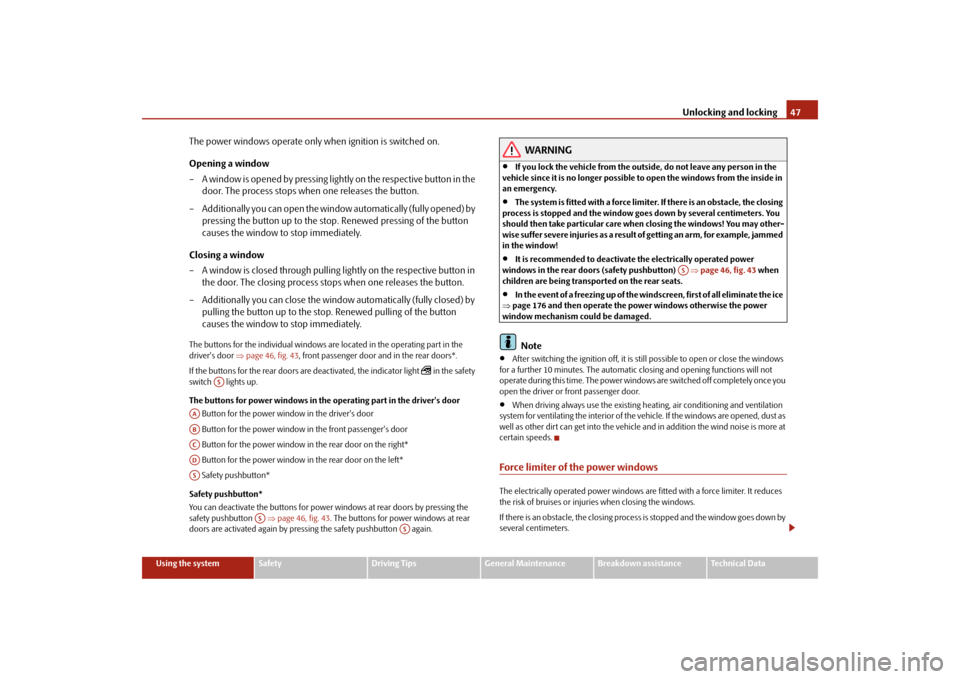
Unlocking and locking47
Using the system
Safety
Driving Tips
General Maintenance
Breakdown assistance
Technical Data
The power windows operate only when ignition is switched on.
Opening a window
– A window is opened by pres sing lightly on the respective butto n in the
door. The process stops when one releases the button.
– Additionally you can open the window automatically (fully opened) by
pressing the button up to the stop. Renewed pressing of the button
causes the window to stop immediately.
Closing a window
– A window is closed through pulling lightly on the respective button in
the door. The closing process stops when one releases the button.
– Additionally you can close the window automatically (fully closed) by
pulling the button up to the stop. Renewed pulling of the button
causes the window to stop immediately.The buttons for the individual windows are located in the operating part in the
driver's door ⇒page 46, fig. 43, front passenger door and in the rear doors*.
If the buttons for the rear doors are deactivated, the indicator light
in the safety
switch lights up.
The buttons for power windows in the operating part in the driver's door
Button for the power window in the driver's door
Button for the power window in the front passenger's door
Button for the power window in the rear door on the right*
Button for the power window in the rear door on the left*
Safety pushbutton*
Safety pushbutton*
You can deactivate the buttons for power windows at rear doors by pressing the
safety pushbutton ⇒page 46, fig. 43. The buttons for power windows at rear
doors are activated again by pressing the safety pushbutton again.
WARNING
•
If you lock the vehicle from the outside, do not leave any person in the
vehicle since it is no longer possible to open the windows from the inside in
an emergency.
•
The system is fitted with a force limiter. If there is an obstacle, the closing
process is stopped and the window goes down by several centimeters. You
should then take particular care when closing the windows! You may other-
wis e suf fe r se v e re inj uri es a s a re s ult of g e tt ing a n ar m , for e xa m ple , ja m m e d
in the window!
•
It is recommended to deactivate the electrically operated power
windows in the rear doors (safety pushbutton) ⇒page 46, fig. 43 when
children are being transported on the rear seats.
•
In the event of a freezing up of the windscreen, first of all eliminate the ice
⇒page 176 and then operate the power windows otherwise the power
window mechanism could be damaged.Note
•
After switching the ignition off, it is still possible to open or close the windows
for a further 10 minutes. The automatic closing and opening functions will not
operate during this time. The power windows are switched off completely once you
open the driver or front passenger door.
•
When driving always use the existing heating, air conditioning and ventilation
system for ventilating the interior of the vehicle. If the windows are opened, dust as
well as other dirt can get into the vehicle and in addition the wind noise is more at
certain speeds.
Force limiter of the power windowsThe electrically operated power windows are fitted with a force limiter. It reduces
the risk of bruises or injuries when closing the windows.
If there is an obstacle, the closing process is stopped and the window goes down by
several centimeters.
AS
AAABACADAS
AS
AS
AS
s3f4.1.book Page 47 Thursday, June 18, 2009 11:07 AM
Page 85 of 259
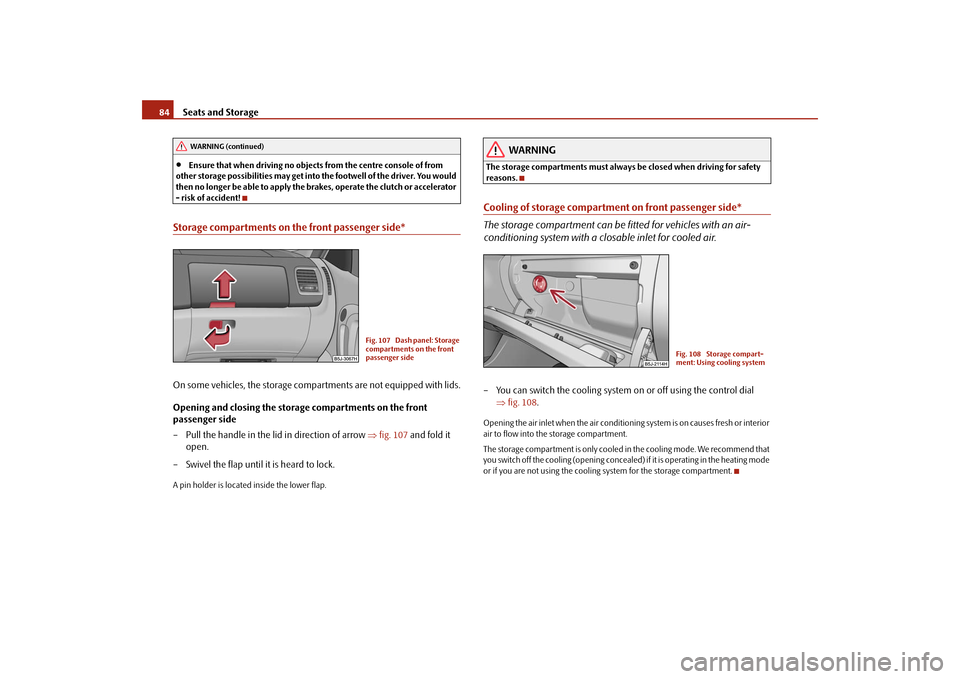
Seats and Storage 84•
Ensure that when driving no objects from the centre console of from
other storage possibilities may get into the footwell of the driver. You would
then no longer be able to apply the brakes, operate the clutch or accelerator
- risk of accident!
Storage compartments on the front passenger side*On some vehicles, the storage compartments are not equipped with lids.
Opening and closing the storage compartments on the front
passenger side
– Pull the handle in the lid in direction of arrow ⇒fig. 107 and fold it
open.
– Swivel the flap until it is heard to lock.A pin holder is located inside the lower flap.
WARNING
The storage compartments must always be closed when driving for safety
reasons.Cooling of storage compartment on front passenger side*
The storage compartment can be fitted for vehicles with an air-
conditioning system with a closable inlet for cooled air.– You can switch the cooling system on or off using the control dial
⇒fig. 108.Opening the air inlet when the air conditioning system is on causes fresh or interior
air to flow into the storage compartment.
The storage compartment is only cooled in the cooling mode. We recommend that
you switch off the cooling (opening concealed) if it is operating in the heating mode
or if you are not using the cooling system for the storage compartment.
WARNING (continued)
Fig. 107 Dash panel: Storage
compartments on the front
passenger side
Fig. 108 Storage compart-
ment: Using cooling system
s3f4.1.book Page 84 Thursday, June 18, 2009 11:07 AM
Page 90 of 259
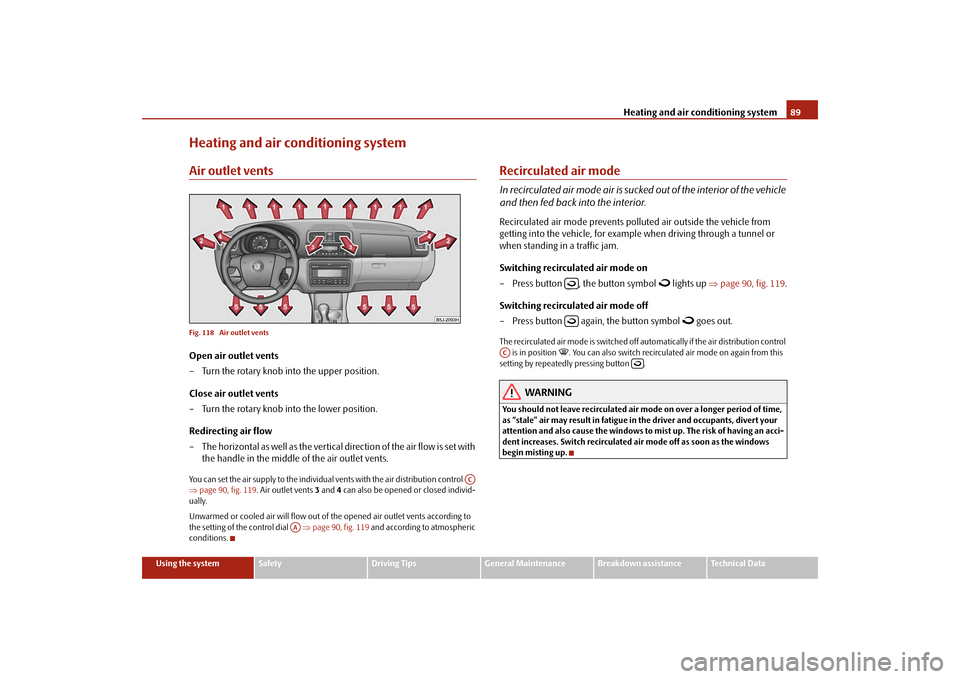
Heating and air conditioning system89
Using the system
Safety
Driving Tips
General Maintenance
Breakdown assistance
Technical Data
Heating and air conditioning systemAir outlet ventsFig. 118 Air outlet ventsOpen air outlet vents
– Turn the rotary knob into the upper position.
Close air outlet vents
– Turn the rotary knob into the lower position.
Redirecting air flow
– The horizontal as well as the vertical direction of the air flow is set with
the handle in the middle of the air outlet vents.You can set the air supply to the individual vents with the air distribution control
⇒page 90, fig. 119. Air outlet vents 3 and 4 can also be opened or closed individ-
ually.
Unwarmed or cooled air will flow out of the opened air outlet vents according to
the setting of the control dial ⇒page 90, fig. 119 and according to atmospheric
conditions.
Recirculated air modeIn recirculated air mode air is sucked out of the interior of the vehicle
and then fed back into the interior.Recirculated air mode prevents polluted air outside the vehicle from
getting into the vehicle, for example when driving through a tunnel or
when standing in a traffic jam.
Switching recirculated air mode on
– Press button , the button symbol
lights up ⇒page 90, fig. 119.
Switching recirculated air mode off
– Press button again, the button symbol
goes out.
The recirculated air mode is switched off automatically if the air distribution control
is in position
. You can also switch recirculated air mode on again from this
setting by repeatedly pressing button .
WARNING
You should not leave recirculated air mode on over a longer period of time,
as “stale” air may result in fatigue in the driver and occupants, divert your
attention and also cause the windows to mist up. The risk of having an acci-
dent increases. Switch recirculated air mode off as soon as the windows
begin misting up.
AC
AA
AC
s3f4.1.book Page 89 Thursday, June 18, 2009 11:07 AM
Page 91 of 259
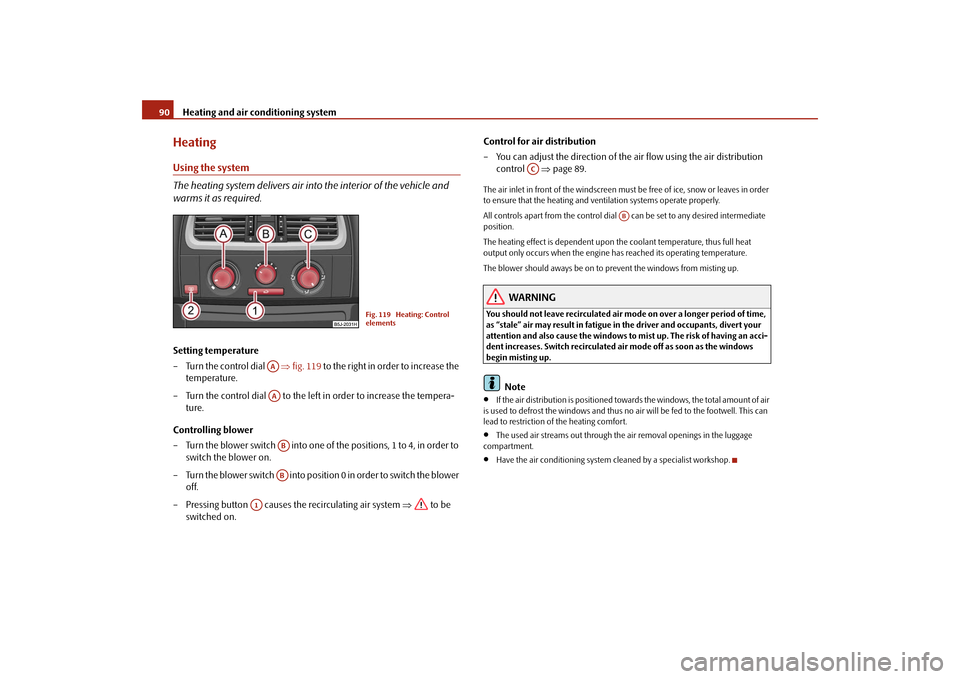
Heating and air conditioning system 90HeatingUsing the system
The heating system delivers air into the interior of the vehicle and
warms it as required.Setting temperature
– Turn the control dial ⇒fig. 119 to the right in order to increase the
temperature.
– Turn the control dial to the left in order to increase the tempera-
ture.
Controlling blower
– Turn the blower switch into one of the positions, 1 to 4, in order to
switch the blower on.
– Turn the blower switch into position 0 in order to switch the blower
off.
– Pressing button causes the recirculating air system ⇒ to be
switched on.Control for air distribution
– You can adjust the direction of the air flow using the air distribution
control ⇒page 89.
The air inlet in front of the windscreen must be free of ice, snow or leaves in order
to ensure that the heating and ventilation systems operate properly.
All controls apart from the control dial can be set to any desired intermediate
position.
The heating effect is dependent upon the coolant temperature, thus full heat
output only occurs when the engine has reached its operating temperature.
The blower should aways be on to prevent the windows from misting up.
WARNING
You should not leave recirculated air mode on over a longer period of time,
as “stale” air may result in fatigue in the driver and occupants, divert your
attention and also cause the windows to mist up. The risk of having an acci-
dent increases. Switch recirculated air mode off as soon as the windows
begin misting up.
Note
•
If the air distribution is positioned towards the windows, the total amount of air
is used to defrost the windows and thus no air will be fed to the footwell. This can
lead to restriction of the heating comfort.
•
The used air streams out through the air removal openings in the luggage
compartment.
•
Have the air conditioning system cleaned by a specialist workshop.
Fig. 119 Heating: Control
elements
AAAAABAB
A1
AC
AB
s3f4.1.book Page 90 Thursday, June 18, 2009 11:07 AM
Page 92 of 259
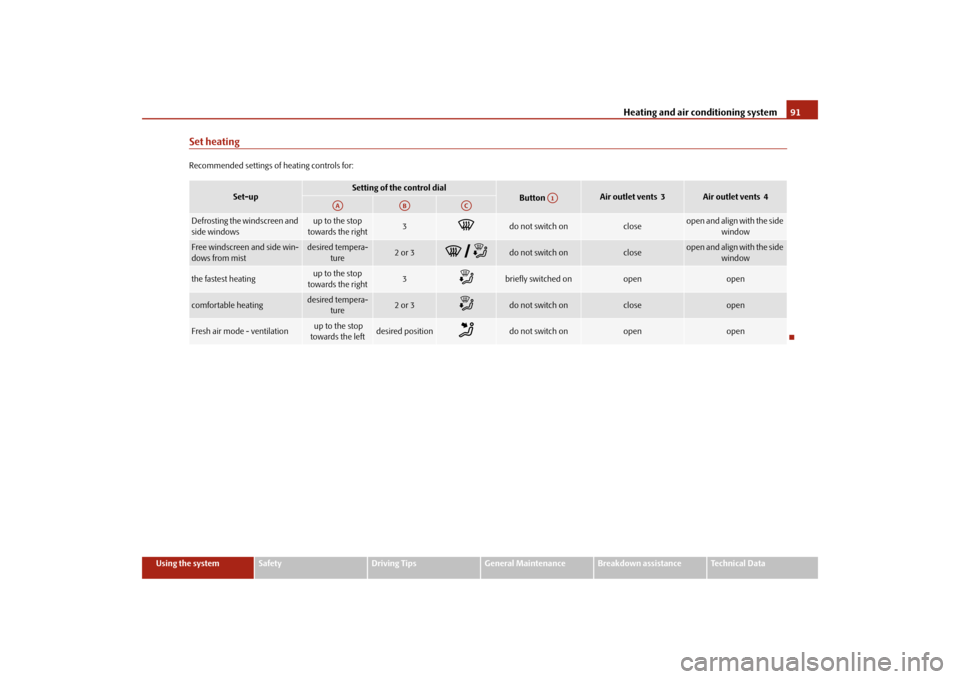
Heating and air conditioning system91
Using the system
Safety
Driving Tips
General Maintenance
Breakdown assistance
Technical Data
Set heatingRecommended settings of heating controls for:
Set-up
Setting of the control dial
Button
Air outlet vents 3
Air outlet vents 4
Defrosting the windscreen and
side windows
up to the stop
towards the right
3
do not switch on
close
open and align with the side
window
Free windscreen and side win-
dows from mist
desired tempera-
ture
2 or 3
do not switch on
close
open and align with the side
window
the fastest heating
up to the stop
towards the right
3
briefly switched on
open
open
comfortable heating
desired tempera-
ture
2 or 3
do not switch on
close
open
Fresh air mode - ventilation
up to the stop
towards the left
desired position
do not switch on
open
open
A1
AA
AB
AC
s3f4.1.book Page 91 Thursday, June 18, 2009 11:07 AM
Page 93 of 259
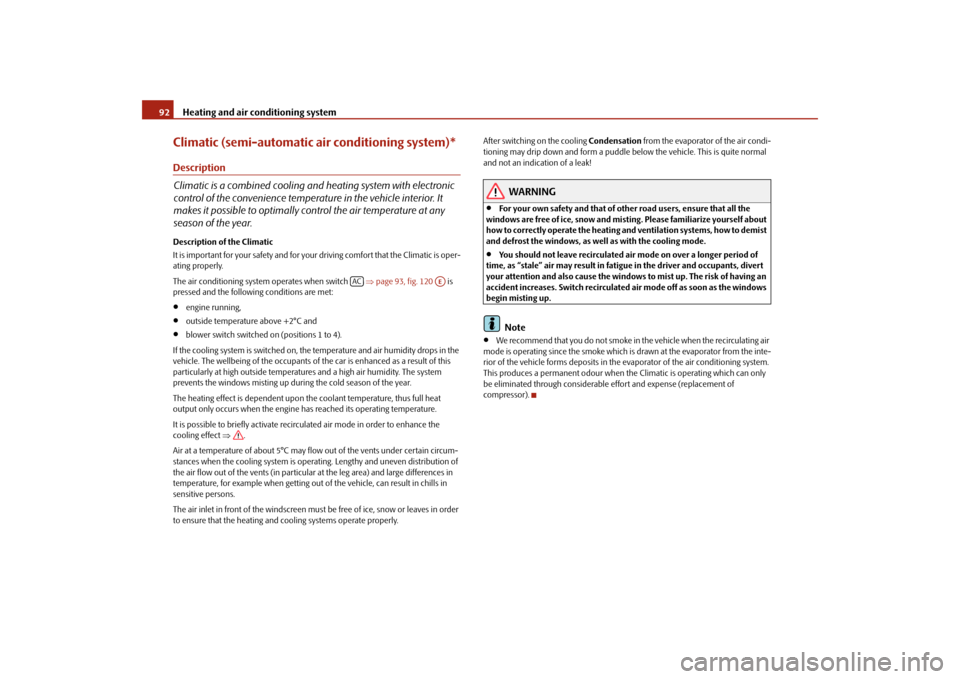
Heating and air conditioning system 92Climatic (semi-automatic air conditioning system)*Description
Climatic is a combined cooling and heating system with electronic
control of the convenience temperature in the vehicle interior. It
makes it possible to optimally control the air temperature at any
season of the year.Description of the Climatic
It is important for your safety and for your driving comfort that the Climatic is oper-
ating properly.
The air conditioning system operates when switch ⇒page 93, fig. 120 is
pressed and the following conditions are met:•
engine running,
•
outside temperature above +2°C and
•
blower switch switched on (positions 1 to 4).
If the cooling system is switched on, the temperature and air humidity drops in the
vehicle. The wellbeing of the occupants of the car is enhanced as a result of this
particularly at high outside temperatures and a high air humidity. The system
prevents the windows misting up during the cold season of the year.
The heating effect is dependent upon the coolant temperature, thus full heat
output only occurs when the engine has reached its operating temperature.
It is possible to briefly activate recirculated air mode in order to enhance the
cooling effect ⇒.
Air at a temperature of about 5°C may flow out of the vents under certain circum-
stances when the cooling system is operating. Lengthy and uneven distribution of
the air flow out of the vents (in particular at the leg area) and large differences in
temperature, for example when getting out of the vehicle, can result in chills in
sensitive persons.
The air inlet in front of the windscreen must be free of ice, snow or leaves in order
to ensure that the heating and cooling systems operate properly.After switching on the cooling Condensation from the evaporator of the air condi-
tioning may drip down and form a puddle below the vehicle. This is quite normal
and not an indication of a leak!
WARNING
•
For your own safety and that of other road users, ensure that all the
windows are free of ice, snow and misting. Please familiarize yourself about
how to correctly operate the heating and ventilation systems, how to demist
and defrost the windows, as well as with the cooling mode.
•
You should not leave recirculated air mode on over a longer period of
time, as “stale” air may result in fatigue in the driver and occupants, divert
your attention and also cause the windows to mist up. The risk of having an
accident increases. Switch recirculated air mode off as soon as the windows
begin misting up.Note
•
We recommend that you do not smoke in the vehicle when the recirculating air
mode is operating since the smoke which is drawn at the evaporator from the inte-
rior of the vehicle forms deposits in the evaporator of the air conditioning system.
This produces a permanent odour when the Climatic is operating which can only
be eliminated through considerable effort and expense (replacement of
compressor).
AC
AE
s3f4.1.book Page 92 Thursday, June 18, 2009 11:07 AM
Page 94 of 259
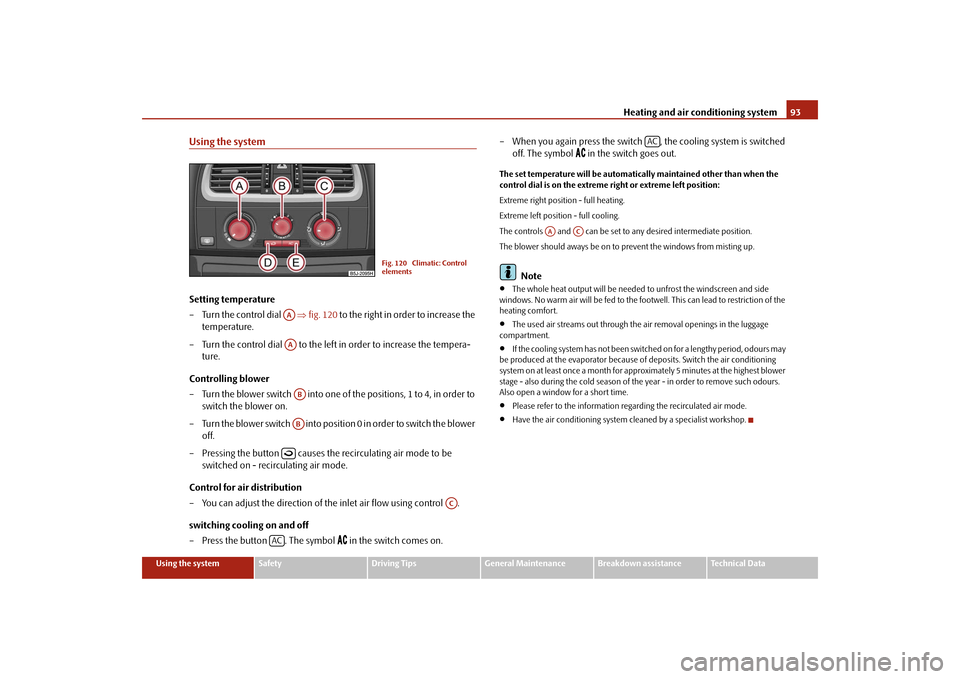
Heating and air conditioning system93
Using the system
Safety
Driving Tips
General Maintenance
Breakdown assistance
Technical Data
Using the systemSetting temperature
– Turn the control dial ⇒fig. 120 to the right in order to increase the
temperature.
– Turn the control dial to the left in order to increase the tempera-
ture.
Controlling blower
– Turn the blower switch into one of the positions, 1 to 4, in order to
switch the blower on.
– Turn the blower switch into position 0 in order to switch the blower
off.
– Pressing the button causes the recirculating air mode to be
switched on - recirculating air mode.
Control for air distribution
– You can adjust the direction of the inlet air flow using control .
switching cooling on and off
– Press the button . The symbol
in the switch comes on.– When you again press the switch , the cooling system is switched
off. The symbol
in the switch goes out.
The set temperature will be automatically maintained other than when the
control dial is on the extreme right or extreme left position:
Extreme right position - full heating.
Extreme left position - full cooling.
The controls and can be set to any desired intermediate position.
The blower should aways be on to prevent the windows from misting up.
Note
•
The whole heat output will be needed to unfrost the windscreen and side
windows. No warm air will be fed to the footwell. This can lead to restriction of the
heating comfort.
•
The used air streams out through the air removal openings in the luggage
compartment.
•
If the cooling system has not been switched on for a lengthy period, odours may
be produced at the evaporator because of deposits. Switch the air conditioning
system on at least once a month for approximately 5 minutes at the highest blower
stage - also during the cold season of the year - in order to remove such odours.
Also open a window for a short time.
•
Please refer to the information regarding the recirculated air mode.
•
Have the air conditioning system cleaned by a specialist workshop.
Fig. 120 Climatic: Control
elements
AAAAABAB
AC
AC
AC
AA
AC
s3f4.1.book Page 93 Thursday, June 18, 2009 11:07 AM
Page 95 of 259
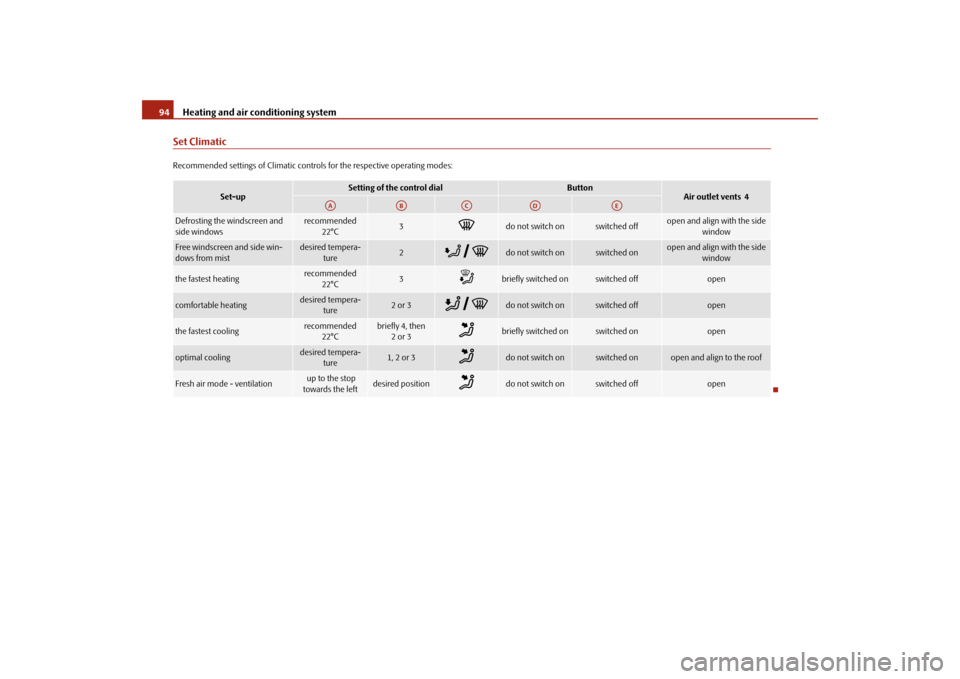
Heating and air conditioning system 94Set ClimaticRecommended settings of Climatic controls for the respective operating modes:
Set-up
Setting of the control dial
Button
Air outlet vents 4
Defrosting the windscreen and
side windows
recommended
22°C
3
do not switch on
switched off
open and align with the side
window
Free windscreen and side win-
dows from mist
desired tempera-
ture
2
do not switch on
switched on
open and align with the side
window
the fastest heating
recommended
22°C
3
briefly switched on
switched off
open
comfortable heating
desired tempera-
ture
2 or 3
do not switch on
switched off
open
the fastest cooling
recommended
22°C
briefly 4, then
2or 3
briefly switched on
switched on
open
optimal cooling
desired tempera-
ture
1, 2 or 3
do not switch on
switched on
open and align to the roof
Fresh air mode - ventilation
up to the stop
towards the left
desired position
do not switch on
switched off
open
AA
AB
AC
AD
AE
s3f4.1.book Page 94 Thursday, June 18, 2009 11:07 AM